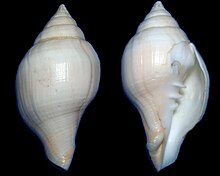Turbinella laevigata, common name the Brazilian chank, is a species of very large sea snail with a gill and an operculum, a marine gastropod mollusk in the subfamily Turbinellinae of the family Turbinellidae.[2]
| Turbinella laevigata | |
|---|---|

| |
| A live individual of Turbinella laevigata in situ | |

| |
| Two views of a shell of Turbinella laevigata | |
| Scientific classification | |
| Domain: | Eukaryota |
| Kingdom: | Animalia |
| Phylum: | Mollusca |
| Class: | Gastropoda |
| Subclass: | Caenogastropoda |
| Order: | Neogastropoda |
| Family: | Turbinellidae |
| Genus: | Turbinella |
| Species: | T. laevigata
|
| Binomial name | |
| Turbinella laevigata | |
| Synonyms | |
| |
Subspecies edit
There are two subspecies of this species:
- Turbinella laevigata laevigata Anton, 1838
- Turbinella laevigata rianae Delsaerdt, 1986 (synonym : Turbinella rianae Delsaerdt, 1987)
Description edit
The shell of this species is thick and heavy, and can grow as large as 20 centimetres (8 in) in length.[3]
Distribution edit
This species is found in Brazil.
Life cycle edit
Turbinella laevigata produces egg capsules which enclose an average of 240 eggs. Approximately ten of these eggs bear young which remain in the capsule for a time after hatching. This is an indication that the remaining 230 eggs are a source of nutrition for these juveniles.[4]
Human use edit
Turbinella laevigata is used as a zootherapeutical product. It is used as a treatment for sexual impotence in traditional Brazilian medicine in the northeast of Brazil.[5]
References edit
- ^ (in German) Anton H. E. 1839. Verzeichniss der Conchylien. Halle, xvi + 110 pp. Turbinella laevigata is on the page 71.
- ^ Rosenberg, G. (2010). Turbinella laevigata Anton, 1838. In: Bouchet, P.; Gofas, S.; Rosenberg, G. (2010) World Marine Mollusca database. Accessed through: World Register of Marine Species at http://www.marinespecies.org/aphia.php?p=taxdetails&id=533539 on 2011-04-03
- ^ Turbinella laevigata Anton, 1838. Malacolog 4.1.1. A Database of Western Atlantic Marine Mollusca, accessed 20 September 2009.
- ^ Matthews-Cascon H., Rocha-Barreira C. de A., Meirelles C., Bigatti G. & Penchaszadeh P. (March–April) 2009. Description of the Ootheca of Turbinella laevigata (Mollusca, Gastropoda). Brazilian Archives of Biology and Technology, 52(2): 359-364.
- ^ Alves R. R. N. 2009. Fauna used in popular medicine in Northeast Brazil. Journal of Ethnobiology and Ethnomedicine 2009, 5:1. doi:10.1186/1746-4269-5-1
External links edit
- Anton, H. E. (1838). Verzeichniss der Conchylien welche sich in der Sammlung von Herrmann Eduard Anton befinden. Herausgegeben von dem Besitzer. Halle: Anton. xvi + 110 pp.
- Kiener L.C. 1840-1841. Spécies général et iconographie des coquilles vivantes. Vol. 6. Famille des Canalifères. Deuxième partie. Genres Pyrule (Pyrula), Lamarck, pp. 1-34, pl. 1-15
- "Turbinella laevigata laevigata". Gastropods.com. Retrieved 16 January 2019.
- Malacolog info